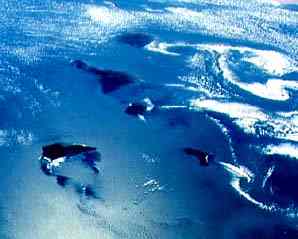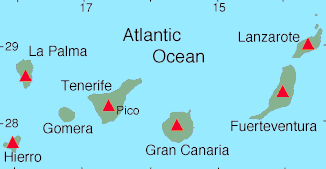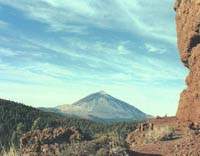|
TENERIFE - CANARY ISLANDS - 1st Port of Call - SUNSHINE ROUTE
|
|||||||||||||||||||||||||||||||||||||||||||||||||||||||||||||||||||||||||||||||||||||||||||||||||||||||||||||||||||||||||||||||||||||||||||||||||||||||||||||||||||||
|
The Canary Islands are a group of seven major volcanic islands that extend for almost 300 miles (500 km) east to west about 60 miles (100 km) off the coast of northwest Africa. Volcanic activity of the island group spans 20 million years and becomes progressively older to the east. The islands probably formed above a fixed hot spot and were carried eastward by the Atlantic Plate. The age for the main subaerial shield phase for Gran Canaria is about 14 million years.
Space Shuttle Photograph
The Canaries today consist of seven islands divided into two areas. The province of Las Palmas brings together the major island of Gran Canaria and the lesser ones of Lanzarote and Fuerteventura. The province of Santa Cruz de Tenerife encompasses Tenerife and its satelite islands of la Gomera. La Palma and Hierro. Within the archipelago there is a variety so extreme that many geologists refer to it as a mini-continent. The isles share an eternal spring climate but they differ dramatically amongst each other. Exploring the Canaries you move from sub-tropical vegetation to volcanic semi-deserts, from verdant cliffs and gorges to sand dunes by the sea shore.
The Canary Islands are Spain's tropical paradise. For many Europeans these Islands are synonymous with holidays and thousands of tourists pack the islands' resorts all year round. Colonized and populated by Spaniards, they lie 1,150km off the coast of Africa.They are politically and administratively Spanish and yet culturally and geographically they have very much their own personality.
View east across the Canary Islands. La Palma is on the bottom left. Tenerife is near the center as seen in the Shuttle photo above. The coast of Africa forms the horizon. Volcanism in the Canary Islands is associated with the transition from continental (Africa) to oceanic (Atlantic) lithosphere within the Africa plate, the effects of the tectonics of the nearby Atlas Mountains, and the very slow movement (about 1 cm per year for the last 60 million years) of the African plate (see references in Carracedo, 1994).
Canary Islands
Location:
28.3N, 16.6W
The island of Tenerife is the largest of the Canary archipelago - 2,053 square kilometres - and it has the shape characteristic of a triangle. The island of eternal spring because of its peerless climate is full of huge contrasts and has a great variety of scenery in the different regions. A mountain chain runs through its centre fro Anaga to Teno and on both of its slopes there are large, exuberantly fertile valleys, among them especially La Orotava and Gumar. In the heart of the chain there is a gigantic, natural crater, called Las Cañadas del Teide, which is about 29 km across and has officially been declared a National Park. It lies over 2,000 m above sea level. North of the crater stands El Pico del Teide, a 3,718 m high mountain, which is the highest point in Spain. It is snow covered in the winter and marks the island with its unique silhouette.
Tenerife satellite photograph
The geology may be described simply: Tenerife is a stratovolcano capped by the Las Canadas caldera. The caldera is 7-12 miles (12-20 km) in diameter and partial filled by Montana Blanca, Pico Viejo (which has a large explosion crater), and Pico de Teide. Pico de Teide and other vents of Tenerife have erupted several times since the island was settled in 1402. The most recent eruption was in 1909. It lasted only ten days, producing lava flows that caused some damage. Thick gray dashed lines show the location of rift zones as proposed by Carracedo (1994). Orotava and Guimar formed as large pieces of the island were removed by landslides. The landslides are caused by the gravitational instability of the large island.
Tenerife has an extremely varied plant life, large, wooded mountains, extensive areas where banana, tomato, potato and other agricultural products are grown. Its coast is rocky and lined by cliffs in some places, while in others there are beaches with soft, clean sand, which are sometimes black and sometimes golden.
The capital of the island and of the province is Santa Cruz de Tenerife, which has 220,000 inhabitants. It is a cheerful, light-filled, modern city on a gentle slope and it is open towards the wide plains in the south. It is the seat of the military headquarters, La Capitanía General de Canarias, and Santa Cruz is known as a hospitable, cordial city. Beautiful gardens, especially García Sanabria, the Municipal Park, and busy streets make it easy for the visitor to feel at home there.
The port in a large bay surrounded by the steep cliffs of the Anaga mountain chain is an important sea traffic and communications centre between Europe, Africa and America. It is visited by ships from all kinds of countries and numerous tourist cruises make it their port of call throughout the year. It is the busiest Spanish port as regards the movement of goods and it is among the most important regarding the number of ships.
The whole city deliberately moves down towards the port and comes to rest, though full of bustling activity, in the nearby España and La Candelaria Squares. Around the latter there are some of the important official buildings, such as El Cabildo Insular, the island government building, where the Archaeological and Anthropological Museum is found; Carta Palace - a curious example of regional architecture and decoration, dating from the 17C and today officially a Sight of Interest to National Art and Architecture -, the Casino Principal, the Monument to the Fallen and El Triunfo de la Candelaria are also found in this area.
La Concepción's is the most important church. Its nave and four aisles shelter interesting Baroque works of art and most valuable reminders of Canary history. There La Cruz de la Conquista, the Cross of Conquest, is kept together with the flags taken from Sir Horace Nelson, the British admiral, on the occasion of his unsuccessful attack on the fortified city. Carta Chapel and the beautiful choir stalls, which are found in the presbytery today, are also of interest to art. Another church worthy of special mention is San Francisco's, which is 18C Baroque next to a beautiful square.
El Teiede
On El Principe Square with its lush laurel trees, there is the Municipal Museum of Paintings and Sculpture, with important paintings by Ribera, B. Brueghel, Madrazo, Van Loo, etc., as well as a department especially dedicated to Canary painting.
On Anaga Avenue, a beautiful, broad thoroughfare skirting the port area of Santa Cruz, there is Paso Alto Castle and its Military Museum. A peaceful place for a walk is near the Royal Yacht Club of Tenerife, which lies in the vicinity of the Nautical School and close to La Casa del mar where there is a magnificent view of the bay.
The Provincial Public Library and the Provincial Office of Records are found in La Casa de la Cultura, comodoro Rodin St. Near the city centre, there are two Places of Interest to National tourism: las Teresitas, with a 1,500m long, artificial beach of golden sand.
One wonders to this day when and how the ancients learnt about this little paradise which Herodotus called the Garden of Hesperides, Homer the Elysian Fields and Pliny the Fortunate isles. Modern contact with the Canaries began to develop in the Middle Ages as sailors from peninsular Spain arrived to plunder the isles of their orchids, which were used to make dye, and of their inhabitants, who were enslaved. Conquest in earnest only began with the Norman adventurer Jean de Bethencourt who, in 1402, claimed Lanzarote on behalf of his feudal lord. Henry III of Castile. In 1483, during the region of the Catholic Monarchs, Pedro de Vera established a base in Gran Canaria and in 1496 Alonso Fenández de Lugo won control of Tenerife. From then on colonization started in earnest.
The original inhabitants of the Canaries were a race known as the Guanches, a name derived from guan, meaning man or people, and achinch, meaning white mountain in an obvious reference to Tenerife's snow-capped Mount Teide. The natives lived a Stone Age existence of shepherding and very rudimentary agriculture. They buried their dead and, in the case of chieftains, mummified the, much like the ancient Egyptians. In Tenerife, Bencome, the mencey or leader of the tribe, fiercely resisted the conquistadors with his flint exes and slings, while in Gran Canaria the ruling guanarteme. Semidán, welcomed the European strangers and established truces.
The isles began to realize their potential for the Crown of Castile as the links developed with the New World. Right at the beginning of that awesome period Christopher Columbus, on his first voyage, rested at La Gomera before venturing into the unknown, westwards in search of the Indies. Before long the Canaies were to become the vital link in transatlantic crossings, a stepping stone between Europe, Africa and the American continent. Last century, as trade and travel increased, the first hotels began to open in Tenerife. Since then commerce and leisure have spread and never ceased developing throughout the archipelago which still retains the paradisiacal qualities that earned it such poetic appellations so many centuries ago.
The islands are the ideal setting for the practice of all kinds of sports. There are many fans of underwater fishing, swimming and whatever other sports there are on the beach and at the swimming pools. The traveller has a thousand training possibilities at the tennis courts, trap-shooting, riding clubs and the magnificent golf courses with a perfect lawn on undulating terrain. There are also occasions to get to know local sports, such as cock fights, the game of sticks, a kind of fencing with two long poles, and the famous Canary catch as-catch-can of remote origin, which requires great skill and strength and is a spectacle of major interest. Another tradition is el salto del regatón or de la garrocha, practiced above all in the island of La Palma.
Temperatures: Minimum, 18ºC in January. Maximum, 24.5ºC in July Canary Underwater Activities Federation: C/ San Sebastián, 76. 2º Floor Santa Cruz de Tenerife Tel: 922 22 67 71 Fax: 922 22 04 85 Canary Underwater Activities Delegation: Apdo. de Correos 1339. Las Palmas de Gran Canaria Tel-fax: 928 23 49 45 Canary Water-Skiing Federation: C/ Pérez Reyes. Pabellón de Deportes de Tacoronte 38350 Tacoronte. Santa Cruz de Tenerife Tel-fax: 922 57 28 13 Canary Sailing Federation: Muelle Deportivo, s/n. Las Palmas de Gran Canaria Tel: 928 23 47 69 Fax: 928 24 24 68 Vela Latina Federation (local sport): Explanada Muelle Deportivo, s/n. Las Palmas de Gran Canaria Tel: 928 23 06 16 Fax: 928 29 33 56 Canary Canoeing Federation: C/ Alemania, 62. Bajo. Las Palmas de Gran Canaria Tel: 928 29 07 16 Fax: 928 24 0l 94 Tenerife Inter-Island Council Sailing School: Vía Auxiliar Paso Alto, s/n. Valleseco 38150 S/C de Tenerife Tel: 922 59 72 58 Canary Speed Boating Federation: C/ San Sebastián, 74. 1ºD. 38005 Santa Cruz de Tenerife Tel: 922 20 48 07 Sea Sports School in San Sebastián de La Gomera: Plaza de Las Américas, 4. 38800 San Sebastián de La Gomera Tel: 922 14 10 72
Sources of Information:
Carracedo, J.C., 1994, The Canary Islands: an example of structural control on the growth of large oceanic-island volcanoes. J. Volcanology and Geothermal Research, v. 60, p. 225-241.
Carracedo, J.C., 1996, Morphological and structural evolution of the western Canary Islands: hotspot-induced three-armed rifts or regional tectonic trends? J. Volcanology and Geothermal Research, v. 72.
Krafft, M., and de Larouziere, F.D., 1991, Guide des Volcans d'Europe et des Canaries, Delachaux et Niestle, Lausanne, 455 p.
Neumann van Padang, M., Richards, A.F., Machado, F., Bravo, T., Baker, E., Le Maitre, W., 1967, Part XXI, Atlantic Ocean: Catalogue of the active volcanoes of the world, International Association of Volcanology, Rome, Italy, 128 p.
Simkin, T., and Siebert, L., 1994, Volcanoes of the World: Geoscience Press, Tucson, Arizona, 349 p.
Solar Cola drinkers care about planet earth
.. Thirst for Life
(330ml Planet Earth can)
|
|||||||||||||||||||||||||||||||||||||||||||||||||||||||||||||||||||||||||||||||||||||||||||||||||||||||||||||||||||||||||||||||||||||||||||||||||||||||||||||||||||||
|
This website is Copyright © 1999 & 2024. The bird logo and name Solar Navigator are trademarks. All rights reserved. All other trademarks are hereby acknowledged. Max Energy Limited is an educational charity.
|




